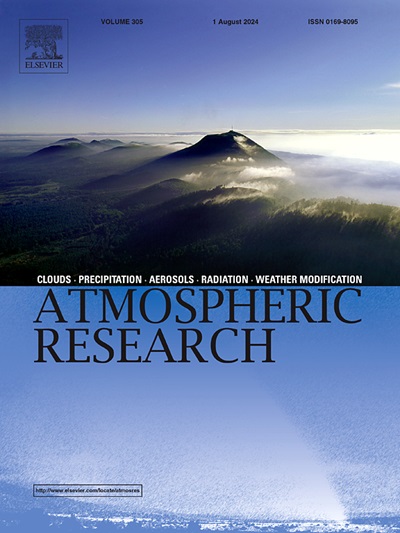Statistical characteristics, circulation patterns, and environmental features of severe convective wind events in Beijing
IF 4.5
2区 地球科学
Q1 METEOROLOGY & ATMOSPHERIC SCIENCES
引用次数: 0
Abstract
A climatological study of 206 severe convective wind (SCW) events from April to September during 2016–2023 in Beijing was conducted. Results show events primarily occur in summer, with a peak in the afternoon and a much weaker secondary peak in the early morning. They are relatively more frequent in mountainous areas than in plains,with the southern foothills of Yanshan Mountain being the most affected area.
Circulation patterns associated with SCW events, ranked by frequency, include the low-pressure vortex-subtropical high, deep trough, low-level jet, subtropical high periphery, transverse trough, dual low-pressure vortex, and easterly flow patterns. Convective organization modes, also ranked by frequency, consist of cluster cells, broken line, nonlinear-shaped systems, hybrid systems, squall line, individual cell, and bow echo. SCW events are mainly triggered by convective systems coming from the northwest and west. In environments with high precipitable water, such as the low-level jet and subtropical high periphery patterns, nonlinear-shaped and hybrid systems are more prevalent. In contrast, in very dry environments, such as the deep trough pattern, broken lines and cluster cells occur more frequently. Strongly organized convective systems, such as squall lines and bow echoes, often exist in circulations with a westerly low-pressure vortex. Generally, a drier atmospheric environment tends to produce stronger winds, while moist conditions increase the frequency of SCW events. These findings highlight the influence of circulation patterns and environmental conditions in SCW events.
对北京 2016-2023 年 4 月至 9 月期间的 206 次强对流风(SCW)事件进行了气候学研究。结果表明,强对流天气主要发生在夏季,午后为高峰,清晨次高峰较弱。与 SCW 事件相关的环流模式按发生频率排序包括低压涡旋-副热带高压、深槽、低空喷流、副热带高压外围、横向槽、双低压涡旋和偏东气流模式。对流组织模式也是按频率排列的,包括集群单元、断裂线、非线性形状系统、混合系统、卷风线、单个单元和弓形回波。SCW 事件主要由来自西北和西部的对流系统引发。在可降水量较高的环境中,如低空喷流和副热带高空外围模式,非线性形系统和混合系统更为普遍。相比之下,在非常干燥的环境中,例如深槽模式,断裂线和集束细胞出现得更频繁。在具有西风低压涡旋的环流中,往往会出现强组织对流系统,如风云线和弓形回波。一般来说,较干燥的大气环境往往会产生较强的风,而潮湿的条件会增加 SCW 事件的频率。这些发现凸显了环流模式和环境条件对 SCW 事件的影响。
本文章由计算机程序翻译,如有差异,请以英文原文为准。
求助全文
约1分钟内获得全文
求助全文
来源期刊

Atmospheric Research
地学-气象与大气科学
CiteScore
9.40
自引率
10.90%
发文量
460
审稿时长
47 days
期刊介绍:
The journal publishes scientific papers (research papers, review articles, letters and notes) dealing with the part of the atmosphere where meteorological events occur. Attention is given to all processes extending from the earth surface to the tropopause, but special emphasis continues to be devoted to the physics of clouds, mesoscale meteorology and air pollution, i.e. atmospheric aerosols; microphysical processes; cloud dynamics and thermodynamics; numerical simulation, climatology, climate change and weather modification.
 求助内容:
求助内容: 应助结果提醒方式:
应助结果提醒方式:


